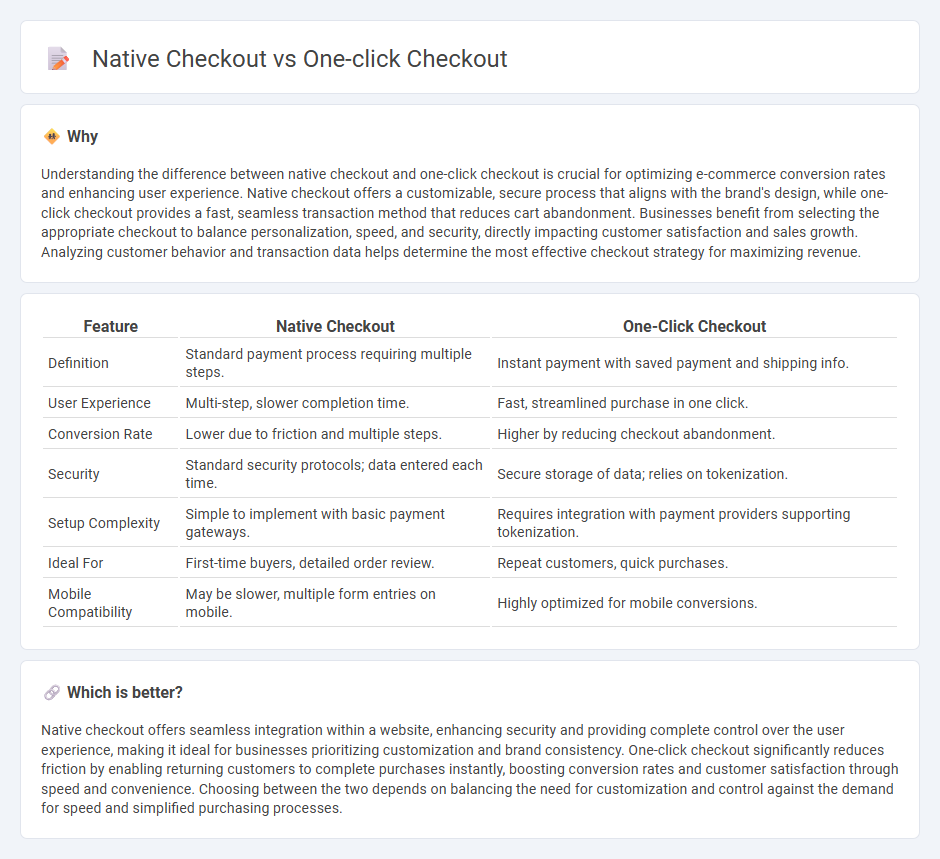
Native checkout integrates seamlessly within a retailer's website, providing a tailored user experience that maintains brand consistency and reduces cart abandonment rates. One-click checkout streamlines the purchasing process by enabling customers to complete transactions instantly with pre-saved payment and shipping information, significantly boosting conversion rates. Explore how these checkout options can enhance your e-commerce strategy and improve sales performance.
Why it is important
Understanding the difference between native checkout and one-click checkout is crucial for optimizing e-commerce conversion rates and enhancing user experience. Native checkout offers a customizable, secure process that aligns with the brand's design, while one-click checkout provides a fast, seamless transaction method that reduces cart abandonment. Businesses benefit from selecting the appropriate checkout to balance personalization, speed, and security, directly impacting customer satisfaction and sales growth. Analyzing customer behavior and transaction data helps determine the most effective checkout strategy for maximizing revenue.
Comparison Table
| Feature | Native Checkout | One-Click Checkout |
|---|---|---|
| Definition | Standard payment process requiring multiple steps. | Instant payment with saved payment and shipping info. |
| User Experience | Multi-step, slower completion time. | Fast, streamlined purchase in one click. |
| Conversion Rate | Lower due to friction and multiple steps. | Higher by reducing checkout abandonment. |
| Security | Standard security protocols; data entered each time. | Secure storage of data; relies on tokenization. |
| Setup Complexity | Simple to implement with basic payment gateways. | Requires integration with payment providers supporting tokenization. |
| Ideal For | First-time buyers, detailed order review. | Repeat customers, quick purchases. |
| Mobile Compatibility | May be slower, multiple form entries on mobile. | Highly optimized for mobile conversions. |
Which is better?
Native checkout offers seamless integration within a website, enhancing security and providing complete control over the user experience, making it ideal for businesses prioritizing customization and brand consistency. One-click checkout significantly reduces friction by enabling returning customers to complete purchases instantly, boosting conversion rates and customer satisfaction through speed and convenience. Choosing between the two depends on balancing the need for customization and control against the demand for speed and simplified purchasing processes.
Connection
Native checkout integrates seamlessly within an e-commerce platform, allowing customers to complete purchases without leaving the site, while one-click checkout streamlines this process by enabling instant transactions with stored payment and shipping information. Both processes focus on reducing friction in the purchasing journey, enhancing user experience, and increasing conversion rates. Leveraging native checkout with one-click functionality boosts efficiency in online commerce by minimizing steps from product selection to payment confirmation.
Key Terms
Conversion Rate
One-click checkout significantly improves conversion rates by minimizing friction during the purchase process and reducing cart abandonment. Native checkout systems offer seamless integration with platform-specific payment methods, enhancing user trust and transaction speed. Explore how these checkout options can optimize your sales funnel and increase revenue.
User Experience
One-click checkout streamlines the purchase process by minimizing clicks and data entry, significantly enhancing user experience with speed and convenience. Native checkout integrates seamlessly within the app or website, offering a familiar interface and reducing friction by utilizing stored user information securely. Explore further to understand which checkout method best maximizes conversion rates and satisfaction for your customers.
Payment Integration
One-click checkout streamlines payment integration by securely storing user payment details for faster transactions, enhancing user experience across e-commerce platforms. Native checkout leverages the platform's built-in payment system, offering seamless compatibility and potentially lower transaction fees while maintaining security standards. Explore how each payment integration impacts conversion rates and user retention by diving deeper into their operational mechanisms.
Source and External Links
The One-Click-Purchase Revolution - Business.com - One-click purchasing allows customers to complete online purchases quickly without reentering payment or shipping details after the first purchase, significantly reducing checkout time and increasing customer spending by about 28.5%.
What Is One-Click Checkout? How To Add It to Your Store (2024) - Shopify - One-click checkout lets customers buy items from an online store with a single click by saving and autofilling their checkout information, with popular options including Shop Pay, PayPal One Touch, and Stripe integrations.
What Is One Click Checkout and How It Works - SamCart - One-click checkout minimizes checkout fatigue by storing a customer's info on their first purchase, enabling subsequent purchases with a single click, and is powered by multiple services like Stripe, Apple Pay, and Google Pay to boost revenue and conversions.
 dowidth.com
dowidth.com